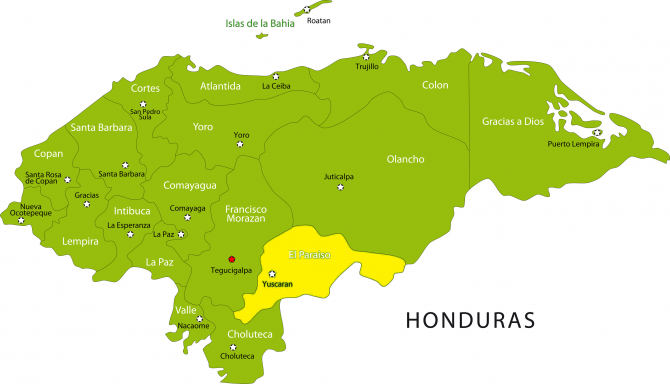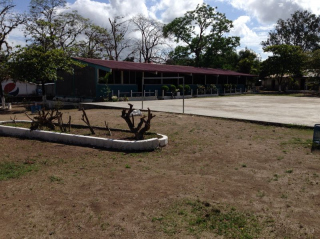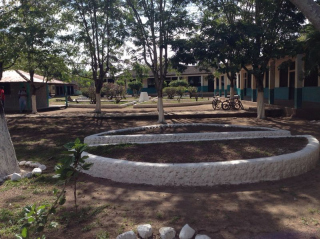Chichicaste, Honduras
![]()
![]()
![]()
![]()
![]()
![]()
![]() Click on Programs to learn more about their work in this community
Click on Programs to learn more about their work in this community
General Information

| Population* | 1900 |
| Number of homes | 500 |
| Avg # of people per home | 3.8 |
| Electricity | Yes |
| GPS |
N 14° 05.214’ W 086° 18.217’ |
| Municipality | Danli |
| Department | El Paraiso |
| Corresponding Health Center | CESAMO-Chichicaste |
| Distance from compounds | 1 hour and 45 minutes |
| Road conditions | Good |
* Population does not reflect how many patients will be seen on medical
brigades as many people from surrounding communities come seeking
Medical Brigades medical attention.
Top Three Needs Expressed
The top three needs expressed by the key community members are better tubing of the water system, a new latrine project, and electricity in some parts of the town that it doesn’t reach currently.

Chichicaste is located in the Danlí municipality of the El Paraíso department.
Chichicaste’s educational system includes Kinder, Primary, Middle, and High schools (until 12th grade). There are 261 students at the schools and it is estimated that about 90% of the community knows how to read and write.
Chichicaste has a water system built by the government in 1990. The main problems with the water system are that the tubing is poor quality, water only arrives every 2 days in each sector, and it is not being chlorinated1. Households are responsible for own water treatment, and though most have a Biosand filter, they don’t always use it. About 98% of the community is connected to the water system. There is a Water Council with 7 active members, led by Santos Ingenio Godoy. The community claims that a small but important improvement would be a “válvula inteligente” (smart valve) for the water system.
Chichicaste has a health center in the community staffed by nurse Arcelia Hernandez. The health center however has struggled with having sufficient water, staff, and medical equipment. There is a Community Health Committee that participates in child-based health programs in collaboration with the local nurse. A kitchen and cafeteria are being constructed at the local school currently for better nutrition programs for kids. Dental care is not available in the community.
The most common illnesses seen by community members are the flu, cough, and diarrhea. Approximately 96% of the community has latrines that currently function. Less than 1% has eco-stoves (estufas justas) and about 90% is estimated to have concrete floors.
No health center information is available from CESAR-Chichicaste2 to date.
The average family income per month is estimated to be about 1000 Lempiras, which is approximately L200 (US $10.59) per person3 or less. Since most people work on their own terrain, they only have income for 6 months of the year when they harvest and are able to sell produce. The majority of homes are made of adobe, though many are also brick and block. The main form of employment in Chichicaste is agriculture on rented land and the main crops that are cultivated are corn and beans. Some members of the community also work in construction. Chichicaste has a communal bank called “Star of the East” started by ARSAGRO in Danlí, an agricultural company, that gives out agricultural loans. They also have access to agricultural loans from BANADESA in Danlí. A cooperative supported by the European Union was formed as well, but didn’t have guarantees, and it lacked follow-up, so they dissembled. The community was interested in also doing a microenterprise in selling natural grains, however the local municipality has not been diligent with reviewing their proposal to grant funding.
Chichicaste does not receive medical brigades from any organizations outside of Global Brigades. About three years ago, an NGO did do a dental hygiene brigade providing fluoride treatments. Latrines were last construction by the Secretary of Health almost 20 years ago.
Chichicaste is a relatively large town that has a large school compound. Though the monthly income is low due to a lack of work opportunities, the physical appearance of the town and its homes do not reflect that level of income. The community members are well-organized and are particularly interested in contributing to an eco-stove project.
 |
 |
 |
 |
Source of information: Key informant interview, Centro de Salud statistics
Date of interview: 26 February 2010
1The accepted regulation frequency for chlorinating water is every 4 days.
2CESAMO and CESAR are terms used for types of health centers. CESAMOs are larger, more comprehensive facilities that usually have a physician on staff at all times and occasionally a dentist. CESARs are more remote, less equipped facilities, usually with 1-2 nurses on staff.
3According to Red Solidaria and World Food Programme in Honduras, the average family is approximated at 5 people per household, the poverty line is L930 (US$49.23) per person per month, and the extreme poverty line is L617 (US$32.66) per person per month.